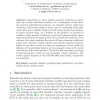1473 search results - page 95 / 295 » Permutation Tests for Classification |
ICIP
2007
IEEE
15 years 4 months ago
2007
IEEE
We propose a framework for exploiting dimension-reducing random projections in detection and classification problems. Our approach is based on the generalized likelihood ratio te...
ICMCS
2005
IEEE
15 years 3 months ago
2005
IEEE
Little attention has been paid so far to physiological signals for emotion recognition compared to audio-visual emotion channels, such as facial expressions or speech. In this pap...
ISMIR
2005
Springer
15 years 3 months ago
2005
Springer
We present a freely available benchmark dataset for audio classification and clustering. This dataset consists of 10 seconds samples of 1886 songs obtained from the Garageband si...
AUSAI
2009
Springer
15 years 1 months ago
2009
Springer
Ensembles are often capable of greater prediction accuracy than any of their individual members. As a consequence of the diversity between individual base-learners, an ensemble wil...
119
click to vote
ADS
2004
Springer
15 years 1 months ago
2004
Springer
Abstract. In this pilot study, a neural architecture for temporal emotion recognition from image sequences is proposed. The investigation aims at the development of key principles ...

